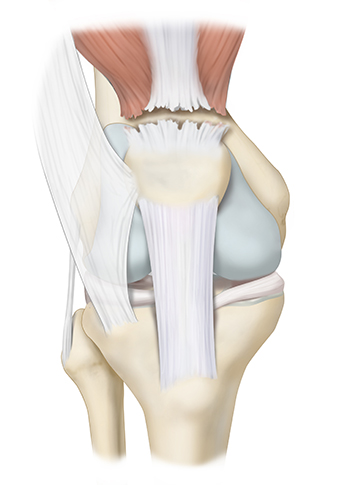Quadriceps Tendon Injuries
The knee joint is supported by several important tendons, which play a crucial role in stabilizing and facilitating the movement of the knee. The quadriceps tendon is located just above the patella and connects the quadriceps muscles in the front of the thigh to the patella. This tendon assists in extending the knee and is integral for movements such as jumping and climbing.
The quadriceps tendon is part of a larger biomechanical structure called the knee extensor mechanism. The knee extensor mechanism is comprised of the patellar tendon, quadriceps tendon, quadriceps muscle group, and the patella. Together, these anatomical structures work to facilitate extension (straightening) of the knee and stability to the knee joint.
A distal quadriceps tendon rupture is a specific type of injury that involves a tear or complete rupture of the quadriceps tendon near its attachment point at the patella. The quadriceps tendon is a strong band of tissue that connects the quadriceps muscles (a group of four muscles at the front of the thigh) to the patella, and it is an essential component of the knee extensor mechanism. When a distal quadriceps tendon rupture occurs, it can significantly impact the ability to straighten the knee and perform activities that require the use of the quadriceps muscles, including walking, jumping, and performing a straight leg raise.

Quadriceps tendon ruptures are typically caused by a sudden, powerful contraction of the quadriceps muscle in your thigh. This can happen from a fall or during activities like jumping, landing, or sudden stops. Chronic overuse and degenerative changes can also contribute to quadriceps tendon injury, especially in older individuals.
- Severe pain in the front of the knee, typically above or around the kneecap.
- Swelling of the knee
- Inability to straighten your knee/perform a straight leg raise.
- Inability to bear weight on the leg.
- A noticeable gap or divot just above the kneecap
- Possible migration of the patella downwards.
A combination of a comprehensive physical examination, x-rays, and an MRI are typically needed to accurately diagnose a quadriceps tendon injury. Dr. Jorge Chahla and his team will perform a physical exam that will include palpating your knee for a tendon gap/divot, testing your ability to perform a straight leg raise, and assessing your range of motion. An x-ray will likely be obtained to rule out fracture and determine if the patella has migrated distally, a condition known as patella baja. An MRI will allow Dr. Chahla to further evaluate the extent of the tendon injury as well as to evaluate the knee for any concomitant ligament, meniscal, or cartilage injuries.
The quadriceps tendon plays a crucial role in knee extension, and injuries to this tendon can cause pain, weakness, and difficulty walking. Partial or complete quadriceps tendon tears often occur due to direct trauma, overuse, or sudden forceful movements. Dr. Jorge Chahla, a leading knee specialist, provides expert diagnosis and treatment for quadriceps tendon injuries, offering both non-surgical and surgical options to restore function. If you have sustained a quadriceps tendon injury, contact Dr. Chahla’s office in Chicago, Naperville, or Oak Brook to explore your treatment options.
At a Glance
Dr. Jorge Chahla
- Triple fellowship-trained sports medicine surgeon
- Performs over 700 surgeries per year
- Associate professor of orthopedic surgery at Rush University
- Learn more

